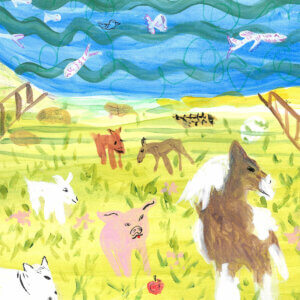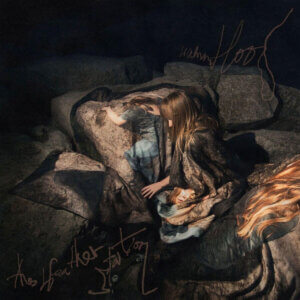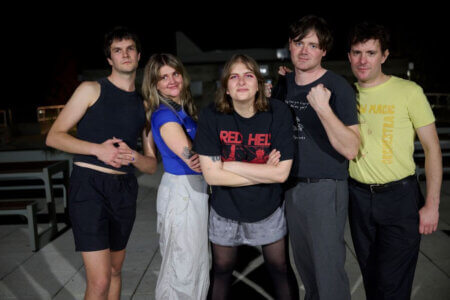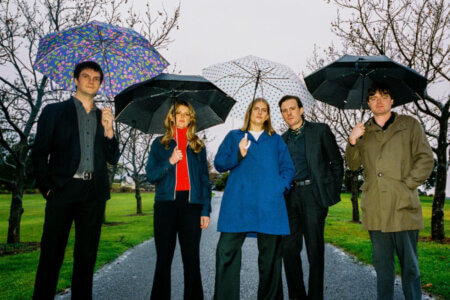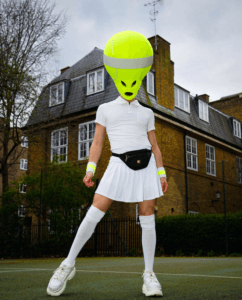H. Hawkline becomes versed in pain on Milk For Flowers
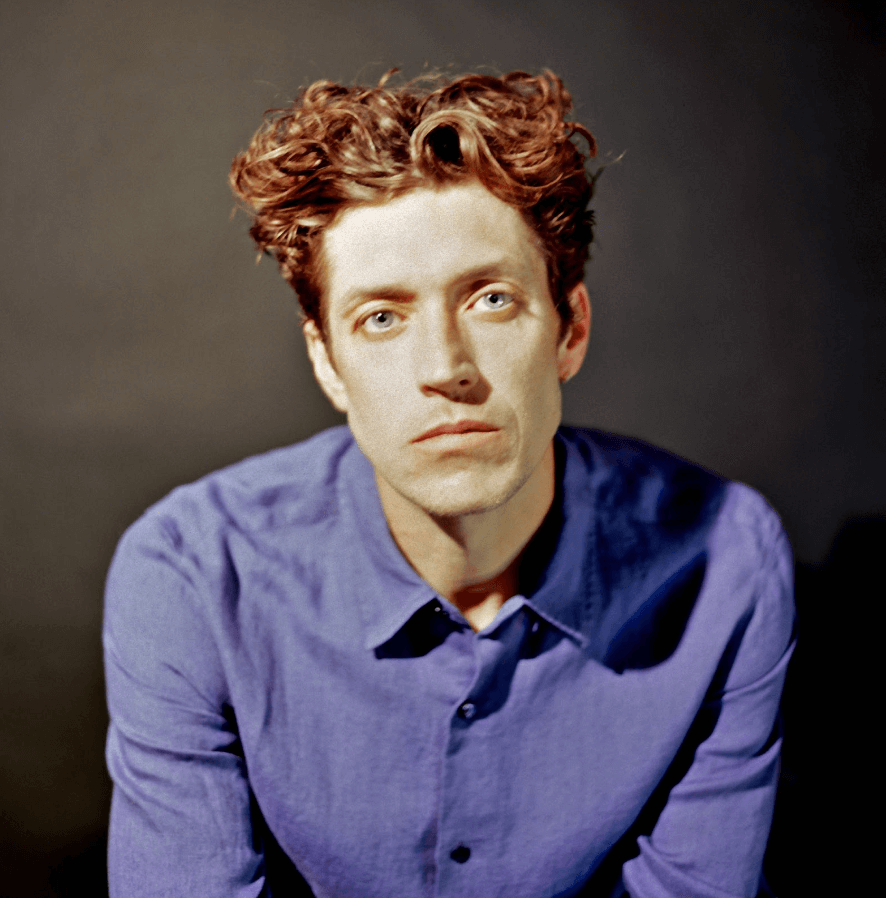
It’s Valentine’s Day when I speak to Welsh songwriter and musician H. Hawkline, born Huw Evans. It’s a sunny afternoon, the first proper indication of spring’s arrival. It’s also a little under a month until H. Hawkline’s fifth solo album Milk For Flowers is due to be released via Heavenly Recordings on March 10. On his latest record, produced with long-time collaborator Cate Le Bon, Evans presents an extraordinarily compelling and intimate body of work that draws the listener into these dynamic arrangements that are all at once infectious, introspective and, ultimately, immensely human.
We spoke about Evan’s different approach to writing Milk For Flowers, the process of healing through music and how dubbed trailers of The Shining on YouTube influenced H. Hawkline’s music videos.
Northern Transmissions: Given that we’re speaking on Valentine’s Day, it feels appropriate to ask if you have a favorite love song?
H. Hawkline: I really like ‘I Have A Woman Inside My Soul’ by Yoko Ono, which is kind of like a love song to herself, in a way. Wow, I’m trying to think what are my favorite love songs?! Paul McCartney obviously writes a great love song in that they’re always just very straightforward, right? There’s no kind of clever language or imagery clouding the sentiment in the way that ‘Maybe I’m Amazed’ is a really beautiful love song because he’s just so in love. ‘Right Down the Line’ by Gerry Rafferty, that’s another amazing love song.
I do have a favorite love poem, it’s more of an anti-love poem, really. There’s an amazing Richard Brautigan poem [titled ‘Love Poem’] that goes, and this is very Valentine’s Day appropriate, “It’s so nice to wake up in the morning all alone and not have to tell somebody you love them when you don’t love them any more”. I think it’s something that loads of people can relate to…maybe!
I think what’s beautiful about that poem is that for a man like Brautigan, who was famed for having such a strange way of saying something, this is just really simple and made complete sense. He had this really beautiful, poetic way of saying things where it would seem completely unconnected to what he was talking about in his work but, at the same time, you just knew what he meant. I think that’s why, from him, that poem is so beautiful as well because he’s just saying what he thinks. So, not only is it an anti-love poem and sentiment, it’s also an anti-love poem in the language he’s using; it’s so sparse and, yeah, it’s just lovely.
You feel a sense of relief when you read it, the rhythm of the poem as well, it kind of ends with a “when you don’t love them… anymore” [he exhales].
NT: All excellent choices with the songs, especially Gerry Raferty! Huw, you’re just a little under being a month away from your new album coming, Milk For Flowers. I’ve been enjoying listening to it a lot and I couldn’t believe it’s been 6 years since your last record I Romanticize. Where has that time gone?!
HH: I know! You know, one of the questions I’ve been asked recently, and it’s a difficult one to answer because so many personal things have happened in that time, is ‘Tell me what happened in the last 6 years!?’ I feel like being like, ‘Well, you tell me what’s happened in your life over the last 6 years!’
So much has happened, it’s bizarre. It’s funny how that can happen sometimes; time just gets away from you. You’re just doing other things; playing music with other people. I think also after I Romanticize, I thought, ‘I don’t have anything to…. Not that I don’t have anything to say, but I don’t know if I know how to say the things I want to say yet. I was still writing songs during that gap but for one reason or another, other stuff got in the way.
NT: You’ve also just been so busy touring with different artists, I remember seeing you playing in Aldous Harding’s band in Dublin in 2019. You also do quite a lot of visual art, too. I only recently realized that you took the portrait for Katy J Pearson’s album artwork.
HH: Yeah, it’s funny, the photography side [of work] is something that happened more recently. And it happened by accident, really. I’m always making something. My room at the minute is, I’ll show you, [he turns his laptop around to show me paper collages on the floor and covering his desk] you can see a lot of weird collages that I’m doing there on the floor and then there’s a table full of crap, as well.
I’m trying to always be making something, even if it’s not employed work. When you’re doing sleeves or visuals for people, it does take a lot of time. And it’s kind of exercising the same part of the brain but in a different way. I find it difficult then to do that and music at the same time. So, if I’m working on a sleeve, I’m focusing solely on that. But, say with photography, I mean I would never call myself a photographer! It started because I took photos of Cate [Le Bon], and somebody liked one of them and then I took photos of somebody else and then I took photos of Aldous [Harding] for her album artwork. It just kind of happened by accident.
NT: So would you say then that music and visual art are quite separate to you, in practice? Does that mean that perhaps one of your photos or collages never informs your songwriting or vice versa?
HH: It doesn’t. I can only speak for my own record, but I’m certainly not thinking about the record cover whilst I’m writing the music. The music is typically finished and then I go, ‘What image goes with what I’ve been writing?’
Sometimes you get obvious visual cues when you’re writing but I think they do overlap in the sense that it’s about finding balance, I suppose. Be it lyrically, musically, if you’re designing something or painting or making a collage; it’s all about how to make something balance but how to do that in an unbalanced way. It’s not just that you go, ‘Oh well I’ll just put these two similarly weighted objects next to each other’. It’s about exploring ways of making a very small thing balance with a really heavy thing; moving them into certain positions to find how to get them to sit beside each other in an unnatural way. Physically it shouldn’t work, but how do you make it work? There’s a bit of that going on, visually and musically, in my work.
NT: I guess we don’t need to go much further than your music videos for the singles for Milk For Flowers which are made using the same visuals for ‘Milk For Flowers’ and ‘Plastic Man’. Tell me a bit about the inspiration for this idea.
HH: Well, initially, it was born out of necessity because I don’t have a massive music video budget, don’t get me wrong, I’m very lucky to have one at all. But, I was talking to my friend one day and often we have conversations where weird ideas are born out of them. Anyway, I had finished the album and was starting to think about the visual side to the record and he was asking me what I wanted to do about the videos. I felt that musically the album is more widescreen than anything I’d previously done so I wanted to try to do something cinematic or certainly something glossier than I’ve done in the past.
However, to achieve exactly what I wanted with the videos, I would have needed a lot more money. As a joke, I thought that the answer was to spend the budget for making three music videos and make one and change the song. When I said that to my friend he laughed, but was like, ‘That’s actually quite a good idea’. We were both kind of laughing about it and discussing how you could do something like that and how funny it could be. When I was driving home after seeing him, I sort of started thinking about it seriously. I could see that, as well as it being a kind of financially subversive solution, it also had some artistic merit to it. I don’t know if you know the amazing movie trailers on YouTube, I think the most famous one is for The Shining. Somebody has put, I think it’s a Paul Simon song and a new voice over a trailer for The Shining and it’s still Jack Nicholson smashing through the door with an axe and it’s him in the maze frozen and that ominous driving shot. But, instead of seeing those scenes, especially the shot of the car driving to the original score, it’s really scary. It’s daytime and they’re driving to a hotel but you’re watching it thinking that some bad stuff is about to go down.
But, you swap the original score for Paul Simon and it makes it seem like they’re going on a family holiday…
NT: It’s like an Adam Sandler movie!
HH: Yeah! The voiceover is like, ‘Jack Torrance just needed to get away!’He’s smashing through the door but it suddenly looks like it’s comedy. His smile in those scenes, rather than being this evil, scary guy that he plays, he looks like a clown.
I was thinking that’s what I’ll do with the video because after a big life changing event, life can feel a bit like that. Your emotions all become one. I think, as well, people find it harder to read you because maybe you’ve suppressed certain things and…Grief is like a song. It plays in your head all the time. Things that would have made you happy make you feel sad. Places you loved, you can’t go to anymore. Things you would have looked at for comfort can bring you immense pain. So, in a kind of sense, when I started thinking about all of these things I was like, ‘You know what, this video idea, it’s maybe a sneaky thing to do but I can make it and it be for the right reasons.’
The video for ‘Empty Room’ has a whole different ending to it which resolves the three of them quite nicely, I think. ‘Milk For Flowers’ and ‘Plastic Man’ have a different emotion; they have a similar bounce and tempo whereas ‘Empty Room’ is much slower. I think with this last song, suddenly, it feels like a completely different video.
NT: Yeah, when I first heard “Empty Room’, which closes the album, I don’t know whether it was the combination of the pedal steel, the piano and your voice or the sentiment in the lyrics, but every time I listened to it, I got quite emotional. I found it really impactful and emotionally effective. The album as a whole, I felt has that sense of dueling happiness and sadness. And, as you said, the arrangements can be uptempo and infectious but there are so many instances where your lyrics are vulnerable and striking in their own way outside of the music. How was it for you to channel those emotions and to be so straightforward in how you expressed them?
HH: With the happy-sad combination, I mean, there’s nothing sadder than a clown.
For me, when you put sad lyrics on top of an upbeat song that has a much greater impact. You can tell somebody how to feel with music by putting a minor chord in the song and the person listening is like, ‘Ok, we’re in sad song territory now!’ Whereas, I think setting sad lyrics to something more upbeat is more jarring and impactful.
In the past I felt the need to dress-up experiences in my lyrics so that they became more interesting; how do I add drama to this situation? I was trying to make people feel things. When I was writing lyrics for [Milk For Flower], I realized quite early on that just writing down something that had happened or something that had been said, without any poetry and without any dressing, was more than enough. It weirdly comes back to that Richard Brautigan poem, you know sometimes you just write down a thing and it perfectly sums up a feeling.
I think having those kinds of lyrics in the album juxtaposed with more poetic language or imagery makes it interesting. Because you can actually, within all of those poetic images, just write a sentence which is captured just as it happened in life. But the listener doesn’t know that, or potentially might not know. They might hear a line and see that as being poetry, when actually it’s a direct thing or experience.
It was difficult to do at times, but also the only thing I could do because there was no dressing-up for certain things. There was no way of making it poetic. They were just things I needed to say. I needed to say that I missed someone. I needed to just say ‘I miss you’ in a song. It felt like a very real communication then when I did that in ‘Milk For Flowers’. I had been writing all these different things down when I was working on that song and when I got to the Middle 8 I was like, ‘What do I want to say here?’ I just thought, ‘I really miss someone’, and so I said to myself, ‘Ok, I’ll just say that’.
Some of the songs for the album were difficult to write, but there was no other way of writing most of them. It all just happened quite naturally and, strangely, less thought went into these lyrics than ones I’d written in the past. Lyrically, I would say that some of those older songs are quite labored. With this [album], though, I didn’t have to think about it. There was stuff there and I just wrote it all down.
NT: Did it help you?
HH: Oh, nothing helps you, I don’t think!
I think what’s difficult about it is that sometimes I find it hard to admit that something helped me. It does help, it definitely helped. It must help because if you keep it all inside, you’ll go completely mad.
For me, the hardest thing with this record was that with something this personal to then make so public, it felt like a betrayal. That’s something I wrestled with all the time, particularly when doing interviews. But, you know, they can be a nice conversation you have about something and I do think they’re important. I enjoy reading interviews and they’re fun to have and look back on. Sometimes, as well, I find that somebody else can give you a perspective on something you wrote that hadn’t even occurred to you. Ultimately, though, with this album it’s been hard because there were more people involved in this than just me, but nobody else has a voice in it/ I’m the only one who has a voice and that can feel like a betrayal.
Even for me to say, ‘This thing was really difficult’, can feel like a betrayal because it could have been harder for somebody else. That’s the thing I think I find quite difficult with this record. It was cathartic, but it has this strange background…Something about the process is kind of off and I’m struggling with that at the minute; maybe I’m trying to come to terms with what I’m doing. I think that will work itself out, eventually. And, maybe I’m not meant to feel comfortable with it. I don’t want it to be my sad story, but that’s what it is. It’s a bit of a weird one, really.
NT: Finally, there’s a line in the song ‘It’s A Living’ that I was drawn to, “Old women, young children can teach you everything you need to know about living.” What are some of the things that old women and young children have taught you about living?
HH: I mean, the obvious things, really! Young children don’t care and they care too much, as well. They don’t have control over their emotions and I think that’s a really important thing. When children are sad, they cry. When they’re happy, they’re ecstatic and when they’re angry, they’re really angry. Whereas adults, we suppress so many emotions because maybe a particular emotion isn’t always suitable for certain situations. Or else you can think, ‘I can’t feel like that now, people are here’. That freedom to just feel how you’re feeling and say what you’re thinking comes from being around young children.
Old women, well, they teach you how to love and they care for you. I think all of my best qualities, I got from my mother. All the best things about me are just from being cared for by that person.
Purchase Milk For Flowers by H. Hawkline HERE
Latest Reviews
Tracks
Advertisement
Looking for something new to listen to?
Sign up to our all-new newsletter for top-notch reviews, news, videos and playlists.


